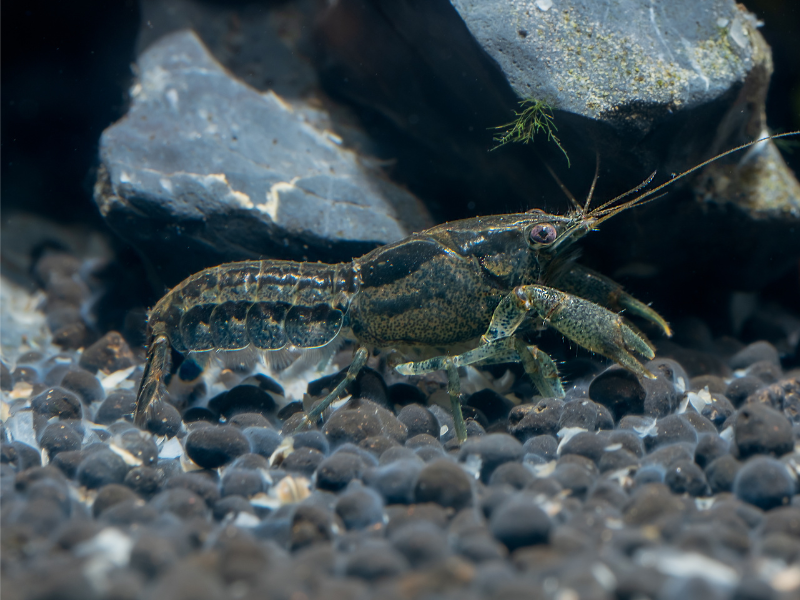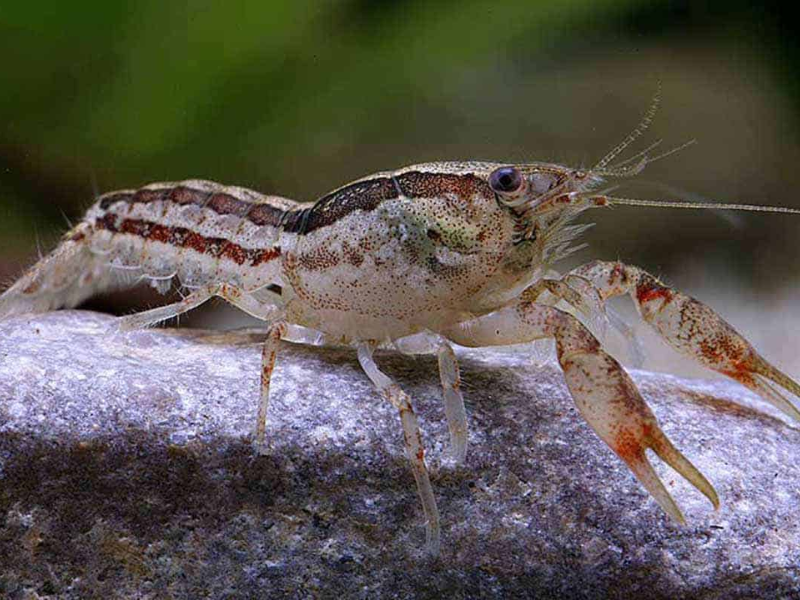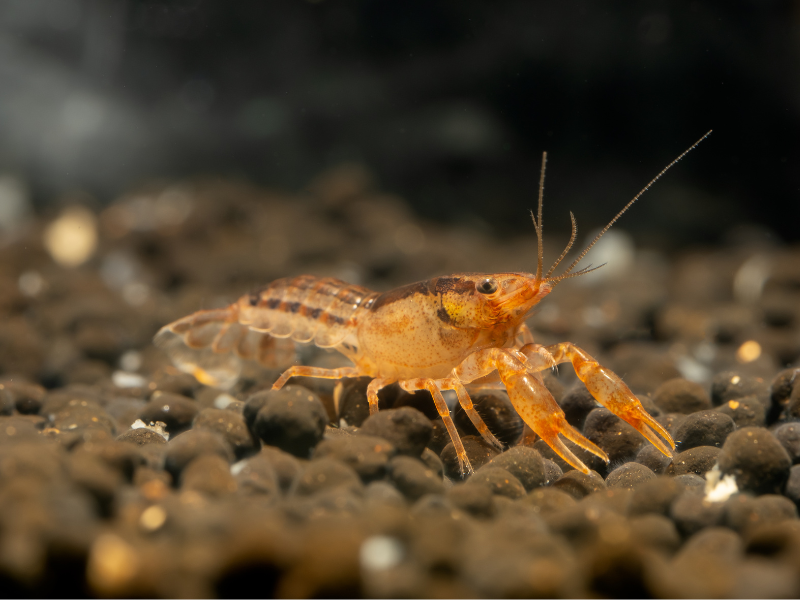Cambarellus diminutus
Least Crayfish

Scientific Classification
Kingdom:Animalia
Phylum:Arthropoda
Class:Malacostraca
Order:Decapoda
Family:Cambaridae
Genus:Cambarellus
Species:diminutus
IUCN Status:Data Deficient
Quick Stats
Difficulty
Medium
Environment
Freshwater
Temperature
20-25°C
pH Level
6.5 - 8
Water Hardness
53 - 179 ppm
Lifespan
2 years
Origin
North America
Adult Size
2-2.5cm
Diet
Omnivore
Creature Type
Crustacean
TDS
250 ppm
Water Flow
Low Flow
Aquarium Building Information
Minimum Tank Size
10L
Swimming Zone
bottom
Oxygen Consumption
Very Low
Waste Production
Very Low
Metabolism Rate
Low
Activity Level
Moderate
Feeding Frequency
Daily
Food Types
Sinking Pellets
Wafers
Frozen Food
Live Food
Vegetables
Algae
Detritus
About This Species
Basic Description
The Least Crayfish is a true nano crustacean from North America and one of the smallest crayfish species, making it a fascinating choice for small aquariums. These tiny invertebrates are perfect for dedicated nano tanks where their interesting behaviors can be observed up close. As omnivores, they are not picky eaters and will readily consume a variety of foods, including sinking pellets, wafers, and blanched vegetables. In the aquarium, they act as a diligent cleanup crew, constantly scouring the bottom for leftover food, algae, and detritus. Their small size makes their impact on the tank's water quality very minimal. Due to their territorial nature, it is best to provide them with plenty of small caves, crevices, and leaf litter to establish their own spaces. While generally peaceful, they should be housed with caution. Keeping them in a species-only setup is the safest way to ensure their well-being. A crucial aspect of their care is a secure, tight-fitting lid, as these small creatures are known to be surprisingly adept escape artists. For aquarists looking for a unique and active bottom-dweller for a small-scale setup, the Diminutive Dwarf Crayfish is an excellent candidate that brings a lot of personality.
Detailed Description
The Least Crayfish, Cambarellus diminutus, is a diminutive crustacean native to slow-moving freshwater streams, swamps, and ditches in North America. To thrive in a home aquarium, it's essential to replicate this type of environment. A well-established tank with low water flow is ideal, which can be achieved using a sponge filter or by baffling the output of a power filter. The aquarium should be densely decorated with an abundance of hiding spots such as driftwood, catappa leaves, small caves, and dense plantings. This structure is critical not only for security but also for mitigating their natural territorial behavior, allowing individuals to claim personal spaces and retreat when necessary, especially during the vulnerable molting process. Maintaining stable and clean water conditions is paramount, as they are sensitive to poor water quality and sudden parameter shifts. While they have a very low biological impact on the aquarium, regular maintenance should not be overlooked. Their diet is omnivorous and should be varied. A high-quality sinking pellet or wafer can serve as a staple, supplemented with frozen foods like daphnia and bloodworms, as well as blanched vegetables such as zucchini or spinach. They are also efficient scavengers, constantly grazing on biofilm and detritus that accumulates in a mature tank. When considering tank mates, caution is advised. Due to their small size, they are vulnerable to predation by even moderately sized fish. Conversely, their claws, though small, can pose a threat to other dwarf shrimp or fish that are slow-moving with long, flowing fins. The best housing options are a species-only aquarium or a community tank with peaceful, fast-swimming nano fish that inhabit the middle and upper water columns. A tight-fitting lid is an absolute necessity, as these crayfish are known for their ability to climb airline tubing and filter intakes in attempts to escape.
Scientific Description
Cambarellus diminutus is a member of the family Cambaridae, a group that encompasses a large number of North American freshwater crayfish. Belonging to the genus Cambarellus, known as the dwarf crayfishes, this species is among the smallest known decapods in the world. Its specific epithet, 'diminutus,' is Latin for 'diminished' or 'small,' directly referencing its most notable morphological characteristic. Morphologically, C. diminutus exhibits a typical depressiform body shape, a dorsoventral flattening that allows it to navigate tight crevices and seek shelter effectively. Its physiology is characterized by a low metabolic rate, very low oxygen consumption, and minimal waste production, adaptations that suit its existence in low-flow, detritus-rich environments. Ecologically, this species functions as an omnivorous detritivore. It plays a role in its native ecosystem by consuming decaying organic matter, algae, and biofilm, contributing to nutrient cycling. It is, in turn, prey for larger aquatic and terrestrial predators. Native to specific regions of North America, it inhabits lentic or slow-moving lotic freshwater systems. The International Union for Conservation of Nature (IUCN) currently lists Cambarellus diminutus as Data Deficient (DD). This classification signifies that there is inadequate information on its wild population size, distribution, and potential threats to make a direct or indirect assessment of its extinction risk. This highlights a need for further field research to understand its population dynamics and conservation requirements. In a laboratory or captive setting, it is noted for being a strictly freshwater organism with very low tolerance for salinity.
Breeding Description
Breeding the Least Crayfish is a moderately challenging but rewarding endeavor. Success hinges on providing an optimal, stable environment that encourages natural behaviors. A dedicated breeding aquarium is highly recommended to ensure the highest survival rate for the offspring. To begin, it is necessary to correctly identify the sexes. Males can be distinguished by their first pair of swimmerets (pleopods), located on the underside where the tail meets the thorax; these are modified into rigid, L-shaped claspers used for mating. Females lack these modified appendages and instead have a small, circular receptacle between their last two pairs of walking legs. For a harmonious setup, maintain a ratio of one male to several females. This distributes the male's attention and reduces potential stress or aggression towards a single female. The breeding tank should be rich in hiding places like small PVC pipes, cholla wood, and dense plants like Java moss. Conditioning the crayfish with a protein-rich diet of frozen or live foods can help trigger breeding. Following a successful mating, the female will extrude her eggs and attach them to her swimmerets, a state commonly referred to as being 'berried.' She will carry and care for these eggs, constantly fanning them to provide oxygen and prevent fungal growth. It is crucial to maintain pristine water quality and avoid stressing the berried female, as she may drop her eggs if disturbed. After a few weeks, the eggs will hatch into miniature, fully-formed versions of the adults. The craylings will remain with their mother for a short period before becoming independent. At this stage, they are extremely vulnerable to cannibalism, even from their parents. Ample cover, such as leaf litter and moss, is essential for their survival, providing both shelter and a source of microscopic food. It is often best to move the parents to a different tank once the young are free-swimming.
Generate Printable Card
Create a printable card for this creature to display in your store or aquarium. The card includes a QR code for quick access to more information.

